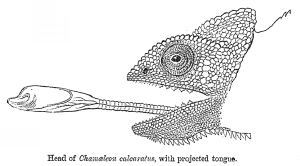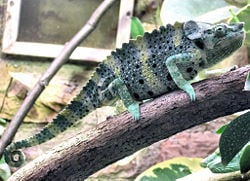Chameleon
| Chameleon | ||||||||||||
|---|---|---|---|---|---|---|---|---|---|---|---|---|
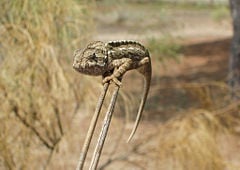 | ||||||||||||
| Scientific classification | ||||||||||||
| ||||||||||||
|
Bradypodion |
Chameleon is any of the tropical, New World lizards comprising the the family Chamaeleonidae, known primarily for their ability to change body color. Chameleons are characterized by very long tongues, bulged eyes that can rotate and focus separately, joined upper and lower eyelids (with a pinhole for viewing), lack of an outer or middle ear (unlike most lizards, but like snakes), and with the five toes on each foot fused into opposite groups of two and three.
Small- to medium-sized squamates, which are primarily tree-dwelling, chameleons are found mainly in sub-Saharan Africa and Madagascar, although some species exist in southern Europe, South Asia, and Australia, with feral populations elsewhere. The common chameleon, Chamaeleo chamaeleon, lives in the Mediterranean area.
The color-changing "American chameleon," Anolis carolinensis, also known as the Carolina or green anole, is not a true chameleon, belonging to the family Polychrotidae (or the subfamily Polychrotinae of the iguana family, Iguanidae).
The name "chameleon" means "earth lion" and is derived from the Greek words chamai (on the ground, on the earth) and leon (lion).
Description
Chameleons vary greatly in size and body structure, with total length from approximately 1 in (2 cm) in Brookesia minima, to the 31 inches (79 cm) in male Furcifer oustaleti[1]. There is even one species, thought to be unique to Malawi's Mount Mulanje, which is barely 0.6 in (1 cm) across when fully grown[citation needed]. Many have head or facial ornamentation, be it nasal protrusions or even horn-like projections in the case of Chamaeleo jacksonii, or large crests on top of their head, like Chamaeleo calyptratus. Many species are sexually dimorphic, and males are typically much more ornamented than the female chameleons.
The main things chameleon species do have in common is their foot structure, their eyes, their lack of ears, and their tongue.
Chameleons are zygodactyl: on each foot the five toes are fused into a group of two and a group of three, giving the foot a tongs-like appearance. These specialized feet allow chameleons to grip tightly to narrow branches. Each toe is equipped with a sharp claw to gain traction on surfaces such as bark when climbing. The claws make it easy to see how many toes are fused into each part of the foot: two toes on the outside of each front foot and three on the inside, and the reverse pattern on each hind foot.
Their eyes are the most distinctive among the reptiles. The upper and lower eyelids are joined, with only a pinhole large enough for the pupil to see through. They can rotate and focus separately to observe two different objects simultaneously. It in effect gives them a full 360-degree arc of vision around their body. When prey is located, both eyes can be focused in the same direction, giving sharp stereoscopic vision and depth perception.
They lack a vomeronasal organ. Also, like snakes, they don't have an outer or a middle ear. This suggests that chameleons might be deaf, although it should be noted that snakes can hear using a bone called the quadrate to transmit sound to the inner ear. Furthermore, some or maybe all chameleons, can communicate via vibrations that travel through solid material like branches.
Chameleons have incredibly long tongues (sometimes longer than their own body length) which they are capable of rapidly and abruptly extending out of the mouth. The tongue whips out faster than our eyes can follow, speeding at 26 body lengths per second. The tongue hits the prey in about 30 thousandths of a second — one tenth of an eye blink.[2] The tongue has a sticky tip on the end, which serves to catch prey items that they would otherwise never be able to reach with their lack of locomotive speed. The tongue's tip is a bulbous ball of muscle, and as it hits its prey, it rapidly forms a small suction cup. Once the tongue sticks to a prey item, it is drawn quickly back into the mouth, where the chameleon's strong jaws crush it and it is consumed. Even a small chameleon is capable of eating a large locust or mantis.
Ultraviolet light is actually part of the visible spectrum for Chameleons. Primarily, this wavelength affects the way a chameleon perceives its environment and the resultant physiological effects. Chameleons exposed to ultraviolet light show increased social behavior and activity levels, are more inclined to bask and feed and are also more likely to reproduce as it has a positive effect on the pineal gland.
Distribution and habitat
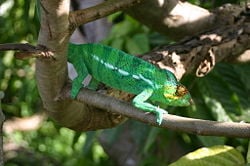
The main distribution of Chameleons is Africa and Madagascar, and other tropical regions, although some species are also found in parts of southern Europe,Asia and Australia . There are introduced, feral populations of veiled and Jackson's chameleons in Hawaii and isolated pockets of feral Jackson's chameleons have been reported in California and Florida.
Different members of this family inhabit all kinds of tropical and montane rain forests, savannas and sometimes semi-deserts and steppes. Chameleons are mostly arboreal and are often found in trees or occasionally on smaller bushes. Some smaller species, however, live on the ground under foliage.
Reproduction
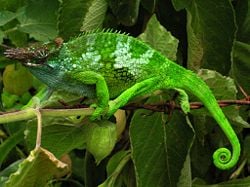
Chameleons are mostly oviparous, with some being ovoviviparous.
The oviparous species lay eggs after a 3-6 week gestation period. Once the eggs are ready to be laid, the female will climb down to the ground and begin digging a hole, anywhere from 4-12 inches (10-30 cm) deep depending on the species. The female turns herself around at the bottom of the hole and deposits her eggs. Once finished, the female buries the eggs and leaves the nesting site. Clutch sizes vary greatly with species. Small Brookesia species may only lay 2-4 eggs, while large Veiled chameleons (Chamaeleo calyptratus) have been known to lay clutches of 80-100 eggs. Clutch sizes can also vary greatly among the same species. Eggs generally hatch after 4-12 months, again depending on species. The eggs of Parson's Chameleon (Calumma parsonii), a species which is rare in captivity, are believed to take upwards of 24 months to hatch.
The ovoviviparous species, such as Jackson's chameleon (Chamaeleo jacksonii) and the Flapjack chameleon (Chamaeleo fuelleborni), give birth to live young after a gestation of 4 to 6 months, depending on the species.
Feeding habits
Chameleons generally eat locusts, mantids, crickets, grasshopper and other insects, but larger chameleons have been known to eat small birds and other lizards. A few species, such as Chamaeleo calyptratus have been known to consume small amounts of plant matter. Chameleons prefer running water to still water.
It was commonly believed in the past that the chameleon lived on air, and didn't consume any food at all. This belief is today represented in symbolic form, with the chameleon often being used as a motif to signify air.
Change of colour
{{#invoke:Message box|ambox}}
Some chameleon species are able to change their skin colour, which has made them one of the most famous lizard families. Changing colour is an expression of the physical and physiological condition of the lizard.[3] The colour also plays an important part in communication.
Despite popular belief, chameleons cannot change colour to their surroundings. Chameleons are naturally coloured for their surroundings as a camouflage.
Chameleons have specialized cells, collectively called chromatophores, that lie in layers under their transparent outer skin. The cells in the upper layer, called xanthophores and erythrophores, contain yellow and red pigments respectively. Below these is another layer of cells called iridophores or guanophores, and they contain the colourless crystalline substance guanine. These reflect, among others, the blue part of incident light. If the upper layer of chromatophores appears mainly yellow, the reflected light becomes green (blue plus yellow). A layer of dark melanin containing melanophores is situated even deeper under the reflective iridophores. The melanophores influence the 'lightness' of the reflected light. All these different pigment cells can rapidly relocate their pigments, thereby influencing the colour of the chameleon.
Pets
Numerous species of chameleon are available in the exotic pet trade. Jackson's Chameleon (Chamaeleo jacksonii) and Veiled Chameleon (C. calyptratus) are by far the most common in captivity. Most species of chameleons are listed on CITES, and therefore are either banned from exportation from their native countries or have strict quotas placed on the numbers exported. However, lack of enforcement in what are mostly poor countries reduces the effectiveness of this listing. Captively bred animals of the most popular species (Panther, Veiled, and Jackson's) are readily found.
Video
File:Camaleón - Calidad- 5.ogg
Notes
- ↑ Glaw, Frank and Vences, Miguel (1994). A Field Guide to Amphibians and Reptiles of Madagascar 2nd edition. Köln: M. Vences & F. Glaw Verlags GbR. ISBN 3-929449-01-3.
- ↑ A Leathal Lashing Tongue
- ↑ Harris, Tom. How Animal Camouflage Works. How Stuff Works. Retrieved 2006-11-13.
External links
- Chameleon Photos
- Reptile Database
- Chameleons! Online E-zine
- Chameleon Care and Information Center website
- The African Herpetology Website
- The Chameleon Forums
- The Advanced Chameleon Keepers website
- Indian Chameleon
- Camaleones
- Chameleon picture taken in South India
Credits
New World Encyclopedia writers and editors rewrote and completed the Wikipedia article in accordance with New World Encyclopedia standards. This article abides by terms of the Creative Commons CC-by-sa 3.0 License (CC-by-sa), which may be used and disseminated with proper attribution. Credit is due under the terms of this license that can reference both the New World Encyclopedia contributors and the selfless volunteer contributors of the Wikimedia Foundation. To cite this article click here for a list of acceptable citing formats.The history of earlier contributions by wikipedians is accessible to researchers here:
The history of this article since it was imported to New World Encyclopedia:
Note: Some restrictions may apply to use of individual images which are separately licensed.
